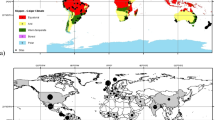Abstract
Effects of dry season upon a tropical rainforest ecosystem are analysed by employing the microcomputer model developed in a previous paper (Oikawa, 1985). Surplus production (P s) illustrated in a three-dimensional figure linearly decreases with the length of dry season (λ). Simulation experiments demonstrate that all the three strata constituting the tropical rainforest ecosystem model are able to exist stably and perpetually unless λ exceeds four months. However, it is suggested that the dry season lasting five months brings about a transition from a tropical rainforest to a subtropical deciduous forest, because the upper story fails in a stable and perpetual occurrence at λ =5 months. Though the total living phytomass gradually decreases with prolonged dry season within four months, supplementary increase of living phytomass is observed in the middle story. A considerable amount of soil organic dead accumulated is also observed with increasing dry season, so that fairly constant ecosystem biomass including soil organic dead is predicted independent of the length of dry season so long as it is less than five months.
Similar content being viewed by others
References
Daubenmire, R. 1972. Phenology and other characteristics of tropical semi-deciduous forest in north-western Costa Rica. J. Ecol.60: 147–170.
Kira, T. 1982. Primary production and carbon cycling in a primeval lowland rainforest of peninsular Malaysia. Internat. Workshop on Special Problems in Physiol. Invest. of Tree Crops. Kottayam, India.
Kuroiwa, S. 1966. Dry-matter production of plants.In: A Series of Mordern Biology Vol. 9, Ecology and Evolution p. 71–100. Iwanami-shoten, Tokyo (in Japanese). Titles are tentative translations for original titles in Japanese by the author.
Monsi, M. 1960. Dry-matter reproduction in plants. I. Schemata of dry-matter reproduction. Bot. Mag. Tokyo73: 81–90.
— 1968. Mathematical models of plant communities.In: F.E. Eckardt, ed. Functioning of Terrestrial Ecosystems at the Primary Production Level p. 131–149. UNESCO, Paris.
— andY. Murata. 1970. Development of photosynthetic systems as influenced by distribution of matter.In: Prediction and Measurement of Photosynthetic Productivity p. 115–130. PUDOC, Wageningen.
Ogawa, H. 1974. Tropical Ecology I.—Forest—. Kyoritsu-shuppan, Tokyo (in Japanese). Titles are tentative translations for original titles in Japanese by the author.
—,K. Yoda andT. Kira. 1961. A preliminary survey on the vegetation of Thailand. Nature & Life in SE Asia1: 21–157.
Oikawa, T. 1985. Simulation of forest carbon dynamics based on a dry-matter production model. I. Fundamental model structure of a tropical rainforest ecosystem. Bot. Mag. Tokyo98: 225–238.
Schulze, E.D. 1982. Plant life forms and their carbon, water and nutrient relations.In: Encyclopedia of Plant Physiology. New ser. 12B, Physiological Plant Ecology II p. 615–676. Springer, Berlin.
Walter, H. 1964. Die Vegetation der Erde. Die tropischen und subtropischen Zonen. 2 Aufl p. 46–51. VEB Gustav Fischer, Jena.
— 1973. Vegetation of the Earth. In Relation to Climate and the Eco-physiological Conditions. (Translated from the second German edition by Joy Wieser)., Springer, New York.
Yoda, K. andT. Kira. 1969. Comparative ecological studies on three main types of forest vegetation in Thailand V. Accumulation and turnover of soil organic matter, with notes on the altitudinal soil sequence on Khao (Mt.) Luang, peninsular Thailand. Nature & Life in SE Asia6: 83–110.
— andM. Nishioka. 1982. Soil respiration in dry and wet seasons in a tropical dry-evergreen forest in Sakaerat, NE Thailand. Jap. J. Ecol.32: 539–541.
Author information
Authors and Affiliations
Rights and permissions
About this article
Cite this article
Oikawa, T. Simulation of forest carbon dynamics based on a dry-matter production model. Bot Mag Tokyo 99, 213–223 (1986). https://doi.org/10.1007/BF02488822
Received:
Issue Date:
DOI: https://doi.org/10.1007/BF02488822




